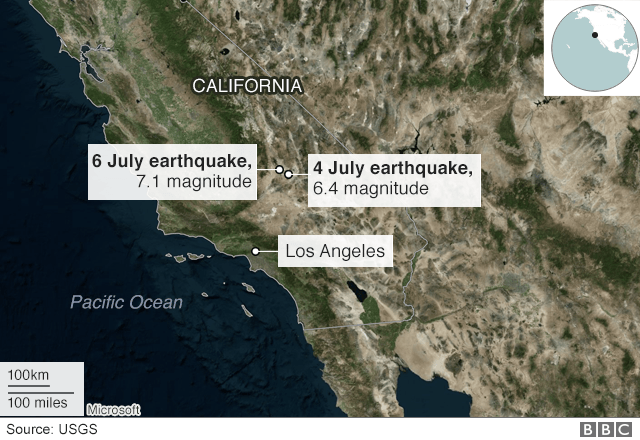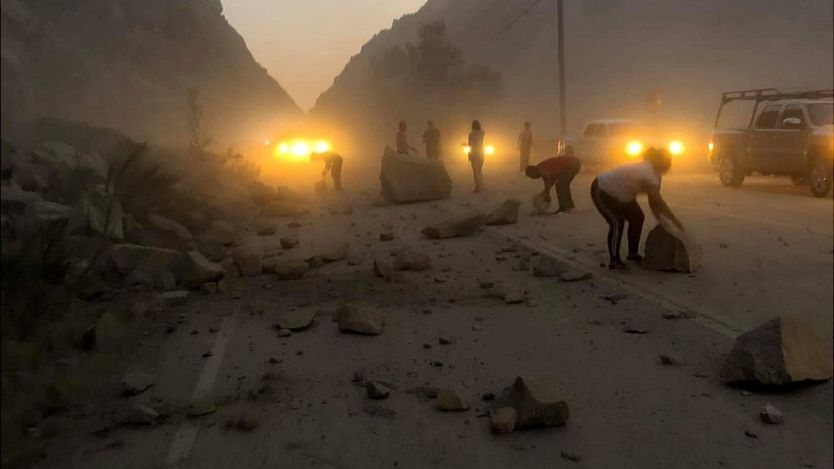Largest earthquake in nearly 20 years rattles Southern California
Another, stronger quake in Ridgecrest shakes Southern California, causing more damage
By ALEJANDRA REYES-VELARDE, ROSANNA XIA, RUBEN VIVES and KAREN KAPLAN
Los Angeles Times
A magnitude 7.1 earthquake struck Southern California on Friday night, the second major temblor in less than two days and one that rocked buildings across Southern California, adding more jitters to an already nervous region.
The quake was centered near Ridgecrest, the location of the July Fourth 6.4 magnitude temblor that was the largest in nearly 20 years. It was followed by an aftershock first reported as 5.5 in magnitude. Scientists said the fault causing the quakes appears to be growing.
Friday night’s quake caused some fires and other damage in and around Ridgecrest and Trona, two Mojave Desert towns shaken by both quakes, said Mark Ghilarducci, director of the California Governor’s Office of Emergency Services. The quake was felt as far away as Phoenix, Las Vegas, Baja California and Reno, according to crowd-sourced data logged into the U.S. Geological Survey’s Did You Feel It? website.
About 3,000 residents in Ridgecrest and the surrounding areas are without power after the earthquake, according to Southern California Edison. In Los Angeles, there were no immediate reports of major damage to buildings and infrastructure, according to the Los Angeles Fire Department.
In Trona and Ridgecrest, residents answered their phones frantically and in fear.
“They’re saying the ground split,” said Winter Wilson, who was driving home to Trona from Bakersfield, her voice shaking. “They made me promise not to come.”
Trona resident Ivan Amerson said he had heard reports from neighbors there was “significant damage” to the town, with houses knocked off their foundations. Amerson evacuated with his family after the first quake and was unsure he could quickly get back, given reports that roads to the town were impassable. New cracks and rockslides closed Highway 178 between the two towns, after damage had been repaired following Thursday’s quake, Caltrans reported.
Ghilarducci said Trona, home to about 2,000 people, reportedly sustained collapsed buildings and gas leaks. Power and communication are out, and the outages have made it difficult for first responders to determine the extent of the damage. “We know that as day breaks, we’ll be able to get a better assessment of the total damage,” he said.
Ghilarducci added that priorities will be to provide support for medical and firefighting needs, as well as trying to get power back on. Maj. Gen. David Baldwin, adjutant general of the California National Guard, said a joint task force that will include 200 security forces and military aircraft will be sent to assist.
The quake caused further damage to a U.S. weapons testing facility outside Ridgecrest, the Naval Air Weapons Station China Lake, although details were sparse early Saturday. “NAWS China Lake is not mission capable until further notice; however, security protocols remain in effect,” the naval base said on its Facebook page after the latest temblor. The installation is the Navy’s largest single landholding, sprawling over 1.1 million acres, an area larger than Rhode Island.
The 7.1 quake that struck at about 8:20 p.m. Friday night was about 10 times larger than the one on Thursday morning, said Lucy Jones, a well-known Caltech seismologist.
The Friday quake occurred on the same fault system as the 6.4 temblor. It was farther away from Los Angeles, though still in the Owens Valley.
“This happened at the end of the zone that moved previously,” Jones said, adding that the fault is now likely to be 25 to 30 miles long.
“The fault is growing,” she said.
Given its size, it’s likely to be followed by more shaking that will be felt in Los Angeles.
“The largest aftershock, on average, to a 7.1 would be a magnitude 6,” Jones said. That means that another quake on the order of Thursday’s 6.4 temblor “would not be surprising to anybody.”
Or it could be even bigger.
Jones said she could not recall a pattern of earthquakes in California where a 6.4 foreshock was followed by a 7.1 event, only to be followed by an even bigger quake.
But that doesn’t mean it can’t happen, she cautioned.
“It is clearly a very energetic sequence, so there’s no reason to think we can’t have more large earthquakes,” she said.
Thursday’s 6.4 foreshock triggered shaking in Ridgecrest of intensity 8. With Friday’s 7.1 quake, the shaking intensity reached a 9, Jones said.
Gov. Gavin Newsom issued a statement late Friday.
“On behalf of all Californians, I offer my heartfelt support to those affected by tonight’s earthquake near Ridgecrest,” the governor said. “The state of California will continue to offer support to aid residents in the region.” He added that he had requested an emergency declaration from the White House and had activated the State Operations Center in Mather, Calif., to its highest level.
Kern County Fire Chief David Witt said his department had responded to multiple structural fires, but there were no reported fatalities. He said there had been many ambulance calls and inspectors were checking the condition of Isabella Lake Dam above Bakersfield, and would continue to investigate. His department has requested assistance from L.A. city and county fire departments and the Orange County Fire Department.
The plan now is to conduct a systematic search in the Ridgecrest area. Helicopters are also assisting.
In Ridgecrest, Jeremiah Jones laughed when a Times reporter asked what the latest earthquake felt like.
“You mean, what didn’t I feel?” he said. “It was bad. Man. It hasn’t stopped yet.”
Jones was minutes away from his home with friends when the earthquake struck. His friends cried and panicked. TVs and cabinets were damaged.
Jones knew his daughters were out of town, giving him a sense of relief, but he returned to his apartment to assess his own damage. He had prepared for this, putting expensive or dangerous items like TVs and things hung on the walls on the floor.
But even with the precautions, his apartment was torn apart.
“All the expensive stuff was secure, but everything off the cabinets and fridge and drawers, closets — everything was thrown everywhere,” he said. “I have a lot to do right now.”
The shaking put nerves on edge at Dodger Stadium, where Becky Carbone, an interior decorator from Norwell, Mass., was watching a game with her husband and two sons, ages 9 and 12, during a visit to the city.
“This one we felt while sitting up high at the Dodgers game,” said Carbone, 43. “The kids were intrigued and basically knew what was happening. I think as Bostonians, we don’t scare easily. And the fact that everyone around us was so calm definitely helped them see that it was OK.”
At the Ahmanson Theatre, the play “Indecent” was underway when the long, rolling quake hit. The cast continued their lines as stage lights swayed above their heads and words projected onto the set blurred.
Audience murmuring grew louder, and the cast was ordered off the set with an announcement that said something like, “Clear the stage. We’re having an earthquake.”
Audience members stayed in their seats, bringing their phones back to life to see how strong the quake was. “7.1!” you could hear people squealing.
The cast remained off stage for about 15 minutes. At one point, a voice from behind the stage said: “Forgive us, we’re from New York,” which drew laughter. When the actors returned to where they had left off, someone yelled out: “Welcome to California.” And the show, as they say, went on.
At the Skirball Cultural Center, dozens of people were eating the last of their chicken and fish at a wedding rehearsal dinner when the tables started shaking.
“People started yelling, ‘Earthquake’ and ‘Do you feel that?’ ” Joanna Korshak, 29, said. “We were outside and we could feel it, which is crazy. And I could see all the windows shaking on the museum.”
“After it was over, everyone started clapping,” Korshak said. Someone could be heard yelling, “Welcome to L.A.” amid the post-earthquake applause. The celebrations quickly resumed, with the father of the groom getting up to make a speech.
When the earlier temblor hit Thursday, scientists had warned that it could lead to an even larger quake. Ridgecrest has been rattled by more than 17 magnitude 4 quakes and at least 1,200 aftershocks since Thursday. A magnitude 5.4 aftershock occurred earlier Friday morning — strong enough to awaken Los Angeles residents about 125 miles away.
“This is an earthquake sequence,” Jones said. “It will be ongoing.”
Friday’s quake was larger in magnitude than the destructive 1994 Northridge quake, which measured 6.7 magnitude. But that temblor occurred in an urban area, while this week’s huge quakes occurred 100 miles from L.A.
A 7.1 quake in 1999 hit the Hector Mines area of the Mojave Desert. Because of its distance from Los Angeles, it did not cause major damage or injuries.
The Fourth of July earthquake had ruptured along a length of fault 10 miles long, from a remote point northeast of Ridgecrest, Calif., a city of 29,000 people, and continued southwest almost all the way to the city limits, scientists said.
The aftershocks will probably “go on for months, if not years,” Caltech seismologist Egill Hauksson said earlier Friday.
The odds, he told The Times, were decent that there could be another aftershock of magnitude 5 or greater at some point.
Times staff writers Phil Willon, Alexa Diaz, Anita Chabria, Seema Mehta, Julia Wick, Ron-Gong Lin II, Mary Forgione and Piper McDaniel contributed to this report.
___
https://www.latimes.com/local/lanow/la-me-major-earthquake-southern-california20190705-story.html

